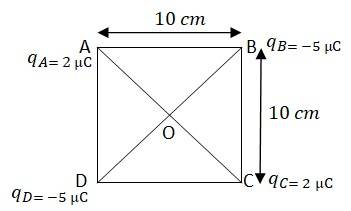Electric Charges and Fields
Get insights from 101 questions on Electric Charges and Fields, answered by students, alumni, and experts. You may also ask and answer any question you like about Electric Charges and Fields
Follow Ask QuestionQuestions
Discussions
Active Users
Followers
New answer posted
6 months agoContributor-Level 10
1.6

In the adjoining figure ABCD is a square with sides AB = BC = CD = DA = 10 cm
Diagonals, AC = BD = = cm
AO = OC = DO = BO = cm
At the centre of the square ABCD, O, a charge of 1
The force of repulsion between the charges placed at A and at O is equal in magnitude but opposite in direction between the charges placed at point C and centre O. Similarly ,the force of attraction between the charges placed at B & O and D & O will be equal in magnitude but opposite in direction. These charges will cancel each other.
Hence, the net charge at centre O will be zero.
Here is a deeper explanation.
What you just saw is the us
New answer posted
6 months agoContributor-Level 10
Ans.1.5 When two bodies are rubbed against each other, it produces charges of equal magnitude in both the bodies but of opposite in nature. Hence the net charges of the two bodies are zero. When a glass rod is rubbed with a silk cloth, similar phenomena occur. This is as per the law of conservation of energy.
New answer posted
6 months agoContributor-Level 10
1.4
(a) Electric charge of a body is quantized, this means that only integers (1,2,3, ….n) number of electrons can be transferred from one body to the other. Charges are not transferred in fraction. Hence, a body possesses total charge only in integers.
(b) In macroscopic i.e. large scale charges, the charges used are huge as compared to the electric charge of electrons or protons. Therefore, it is ignored and it is considered that electric charge is continuous.
New answer posted
6 months agoContributor-Level 10
1.3 The units of the given equation
is
e = Electric charge in C
k = in N where = Permittivity of free space = 8.854
G = Gravitational constant = N
Therefore
= =
So the given equation is dimensionless
We have the following values
e = 1.6 C
G = 6.67 kg
kg
The numerical value of this ratio is given by
= = = =
= 2.284
New question posted
6 months agoNew question posted
6 months agoNew answer posted
6 months agoContributor-Level 10
The fundamental relationship between the resulting electric field and electric charge distribution is given by Gauss's law.
It states that the total electric flux (? E) passing through any closed hypothetical surface (called a Gaussian surface) is equal to 1/?0 times the net electric charge (q enc ) enclosed within that surface.
When dealing with charge distributions that possess a high degree of symmetry such as planar, cylindrical, and spherical, Gauss's law significance lies in providing a powerful alternative method to Coulomb's law for calculating electric fields.
?
New answer posted
6 months agoContributor-Level 10
A region around a charged object, where another object experiences a force is called an electric field. The formula is - E = F / q? where E is the electric field at a point, q? is the small positive test charge placed at that point, and F is the force experienced by q?
The electric field is a vector quantity that has both magnitude and direction. The electric fields are visually represented by the electric field lines. The electric field starts with positive charges and ends with negative charges. The field's strength is indicated by the density of the field lines. The electric fields can be measured in V/m (volts per meter) and N/C (n
New answer posted
6 months agoContributor-Level 10
According to Shiksha's electric charges and fields class 12 notes, Coulomb's law states that if there are two stationary point charges, the electrostatic force between them is inversely proportional to the square of the distance between them and directly proportional to the product of the charges.
Mathematically,
F = (1 / 4? ) * (q? / r²)
Here r is the distance between the charges, q? and q? are charges and? is the permittivity of free space. Coulomb's law assumes charges are at rest and it is valid for point charges in vacuum or air. When the medium is not a vacuum and the charges are moving, the limitations include inaccuracy. This la
Taking an Exam? Selecting a College?
Get authentic answers from experts, students and alumni that you won't find anywhere else
Sign Up on ShikshaOn Shiksha, get access to
- 65k Colleges
- 1.2k Exams
- 679k Reviews
- 1800k Answers
